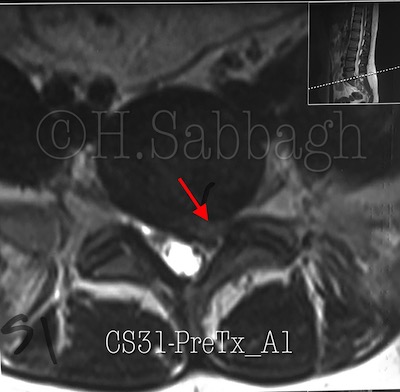Discussion
Sub-articular herniations, particularly if they compromise the lateral recess, can represent a challenge in conservative treatment.
As with the majority of discopathies, treatment should be initiated within the first two weeks, as it can directly affect the prognosis. In this particular case, even though the time lapse was more than 12 weeks, the patient did respond favorably to closed reduction protocol (DPPP-SAA), with no significant complications. Keeping in mind, this was a unique characteristic of this particular case, and similar presentations may require surgical intervention.
Pointing out that in these cases, regular comprehensive re-evaluations during the treatment protocol is mandatory.
An important clinical observation in this particular case was the patient’s lack of response to previous treatment via a supine automated decompression system.
Even so, this method of decompression can be effective in some cases of discopathies. It has been this author’s clinical observations in this and similar cases, that it is clinically indicated in intra-canalicular discopathies with contained protrusions.
In fact, in cases of intra-articular / lateral recess, foraminal, as well as distant lateral involvement, it can actually further exacerbate the radicular symptoms in particular cases. Therefore, an accurate advanced imaging evaluation to determine the specific morphology of the IVD prior to initiation of a treatment protocol is mandatory. No doubt further clinical research in this area is indicated.
It is important to emphasize that the closed reduction protocols such as the DPPP-SAA must be dynamic, allowing for specific tailoring of the treatment procedure for each particular patient. As mentioned before, each session of treatment is often variable as well, and no pre-set formula exists.
Furthermore; it is important to point out that in cases of discopathies such as this, the concept of applying a treatment procedure based on the so-called “patient’s tolerance” is unacceptable. As such, normalizing an increase in a patient’s symptoms during the initial phase of treatment, can also be clinically misleading.
H. Sabbagh D.C.
Published: December 20, 2023
©2023 H. Sabbagh D.C. (All Rights Reserved)

